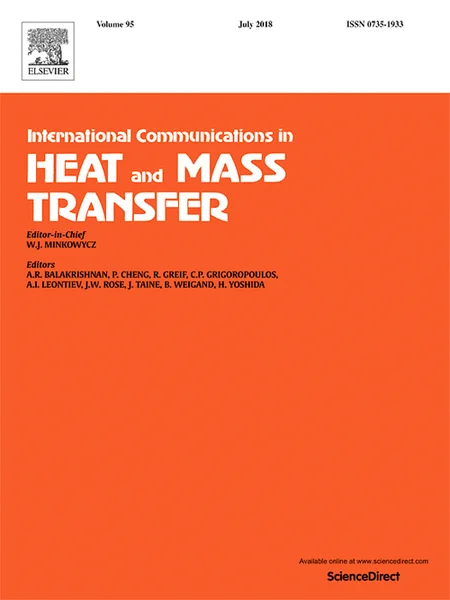-
artificial neural network techniques for the determination of condensation heat transfer characteristics during downward annular flow of r134a inside a vertical smooth tube
جزئیات بیشتر مقاله- تاریخ ارائه: 1397/06/10
- تاریخ انتشار در تی پی بین: 1397/06/10
- تعداد بازدید: 424
- تعداد پرسش و پاسخ ها: 0
- شماره تماس دبیرخانه رویداد: -
in this study, the best artificial intelligence method is investigated to estimate the measured convective heat transfer coefficient and pressure drop of r134a flowing downward inside a vertical smooth copper tube having an inner diameter of 8.1 mm and a length of 500 mm during annular flow numerically. r134a and water are used as working fluids in the tube side and annular side of a double tube heat exchanger, respectively. the ann training sets have the experimental data of in-tube condensation tests including six different mass fluxes of r134a such as 260, 300, 340, 400, 456 and 515 kg m− 2 s− 1, two different saturation temperatures of r134a such as 40 and 50 °c and heat fluxes ranging from 10.16 to 66.61 kw m− 2. the quality of the refrigerant in the test section is calculated considering the temperature and pressure obtained from the experiment. the pressure drop across the test section is directly measured by a differential pressure transducer. input of the anns are the measured values of test section such as mass flux, heat flux, the temperature difference between the tube wall and saturation temperature, average vapor quality, while the outputs of the anns are the experimental condensation heat transfer coefficient and measured pressure drop in the analysis. condensation heat transfer characteristics of r134a are modeled to decide the best approach using several artificial neural network (ann) methods such as multilayer perceptron (mlp), radial basis networks (rbfn), generalized regression neural network (grnn) and adaptive neuro-fuzzy inference system (anfis). elimination process of the ann methods is performed by means of 183 data points, divided into two sets randomly, obtained in the experiments. sets of test and training/validation include 33 and 120/30 data points respectively for the elimination process. validation process, in terms of various experimental conditions, is done by means of 368 experimental data points having 68 data points for test set and 300 data points for training set. in training phase, 5-fold cross validation is used to determine the best value of anns control parameters. the anns performances were measured by means of relative error criteria with the usage of unknown test sets. the performance of the method of multi layer perceptron (mlp) with 5-13-1 architecture and radial basis function networks (rbfn) were found to be in good agreement, predicting the experimental condensation heat transfer coefficient and pressure drop with their deviations being within the range of ± 5% for all tested conditions. dependency of outputs of the anns from input values is also investigated in the paper.
مقالات جدیدترین رویدادها
-
استفاده از تحلیل اهمیت-عملکرد در ارائه الگوی مدیریت خلاقیت سازمانی و ارائه راهکار جهت بهبود
-
بررسی تاثیر ارزش وجوه نقد مازاد بر ساختار سرمایه شرکت های پذیرفته شده در بورس اوراق بهادار تهران
-
بررسی تأثیر سطح افشای ریسک بر قرارداد بدهی شرکت های پذیرفته شده در بورس اوراق بهادار تهران
-
بررسی تأثیر رتبه بندی اعتباری مبتنی بر مدل امتیاز بازار نوظهور بر نقد شوندگی سهام با تأکید بر خصوصی سازی شرکت ها
-
تأثیر آمیخته بازاریابی پوشاک ایرانی بر تصویر ذهنی مشتری پوشاک ایرانی (هاکوپیان)
-
شناسایی و اولویت بندی عوامل مؤثر بر چابکی سازمان با استفاده از تکنیک سلسله مراتبی فازی (موردمطالعه: شرکت ماموت)
-
نقش معماری منازل مسکونی در تربیت فرزندان
-
بررسی تجربی رفتار برشگیرهای به شکل ناودانی نبشی و برشگیر t شکل
-
بررسی ظرفیت باربری نوک شمع در خاک های لایه ای
-
adsorption of 2- methyl-n-(2´-aminoethyl)-3-hydroxyl-4-pyridinone onto functionalized single-walled carbon nanotube: a dft study
مقالات جدیدترین ژورنال ها
-
مدیریت و بررسی افسردگی دانش آموزان دختر مقطع متوسطه دوم در دروان کرونا در شهرستان دزفول
-
مدیریت و بررسی خرد سیاسی در اندیشه ی فردوسی در ادب ایران
-
واکاوی و مدیریت توصیفی قلمدان(جاکلیدی)ضریح در موزه آستان قدس رضوی
-
بررسی تاثیر خلاقیت، دانش و انگیزه کارکنان بر پیشنهادات نوآورانه کارکنان ( مورد مطالعه: هتل های 3 و 4 ستاره استان کرمان)
-
بررسی تاثیر کیفیت سیستم های اطلاعاتی بر تصمیم گیری موفق در شرکتهای تولیدی استان اصفهان (مورد مطالعه: مدیران شرکتهای تولیدی استان اصفهان)
-
درآمدی بر اهمیت فرآورده ها و مشتقات محصولی میوه انار برای مدیریت مسائل انسانی
-
مطالعه تأثیر عدم تقارن اطلاعاتی بر رابطه بین همزمانی قیمت و نقدشوندگی سهام
-
تضمین های حقوق شهروندی متهمان جرایم تروریستی در مرحله تحقیقات؛ مطالعه تطبیقی در حقوق ایران، انگلستان و مصر
-
مقایسه نیروی ترک خوردگی در تیرهای مقاوم سازی شده با hpfrcc نسبت به تیر نمونه مرجع
-
تحلیل و بررسی توسعه فناوری و اهداف اقتصادی دولت اسلامی




سوال خود را در مورد این مقاله مطرح نمایید :